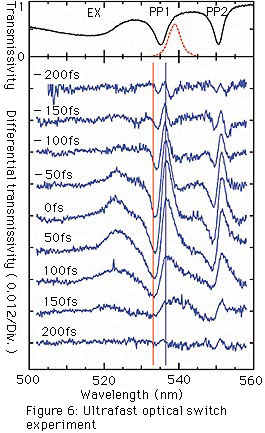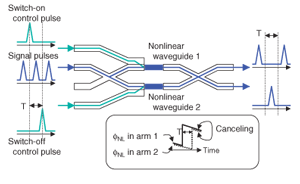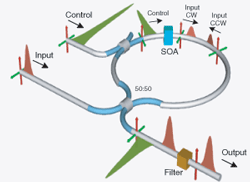
Ultra-fast Switching
In order to optimize transmission speeds for information encoded in femtosecond light pulses, optical switches must also have switching speeds on When the order of femtoseconds. Below are a few selected optical switches that can accommodate ultra-fast optical time division multiplexed signals.
The Optical Stark Effect
When light interacts with a semi-conductor, electron-hole pairs called "excitons" are formed. When a short pulse of light with a wavelength very close to that which excitons in quantum wells absorb, there is a temporary shift in the wavelength that excitons absorb. This phenomenon is known as the "optical Stark effect."

In this diagram describing the quantum well switch with an incident pulse of 100 fs, 0 fs refers to the exact instant at which the pulse maximum is incident on the semi-conductor. One can clearly see that the absorbance changes drastically within 200 fs on either side of the midpoint of the pulse. For an optical signal, having the wavelength corresponding to the shifted absorption for excitons, changes in absorbance could stop the transmission of the signal. If this phenomenon were integrated into an optical switch, with an incident light pulse of a few femtoseconds, it would be conceivable to experience switching speeds of less than 10 fs.
The only problem with this method is that it requires a prohibitively high excitation power.
Symmetric Mach-Zehnder Type All Optical Switches
As mentioned above, optical switches must have a low switching energy in order for the device to be practical in the context of a commercial optical system. Generally, the maximum switching energy allowed in practical considerations is 1 pJ (10-12 Joules).

The figure above is a diagram of a symmetric Mach-Zehnder (SMZ) optical switch. The control pulses can alter the characteristics of the nonlinear waveguides. When a signal passes through these waveguides, the difference in nonlinear phase shifts defines the state of the switch. As shown, this switch can split parts of the signal into two fibers using the priciple of interferometry. The switching speed for this device is determined by little more than the length of the control pulses.
Terahertz Optical Assymetric Demultiplexer (TOAD)
The TOAD switch is essentially a fiber loop joined at the base by an optical coupler. The input signal is then split into two equal parts that propagate around the loop in opposite directions and recombine at the coupler to make the output signal. Also on the loop is another coupler for the addition of a control signal and a semi-conductor optical amplifer (SOA)
